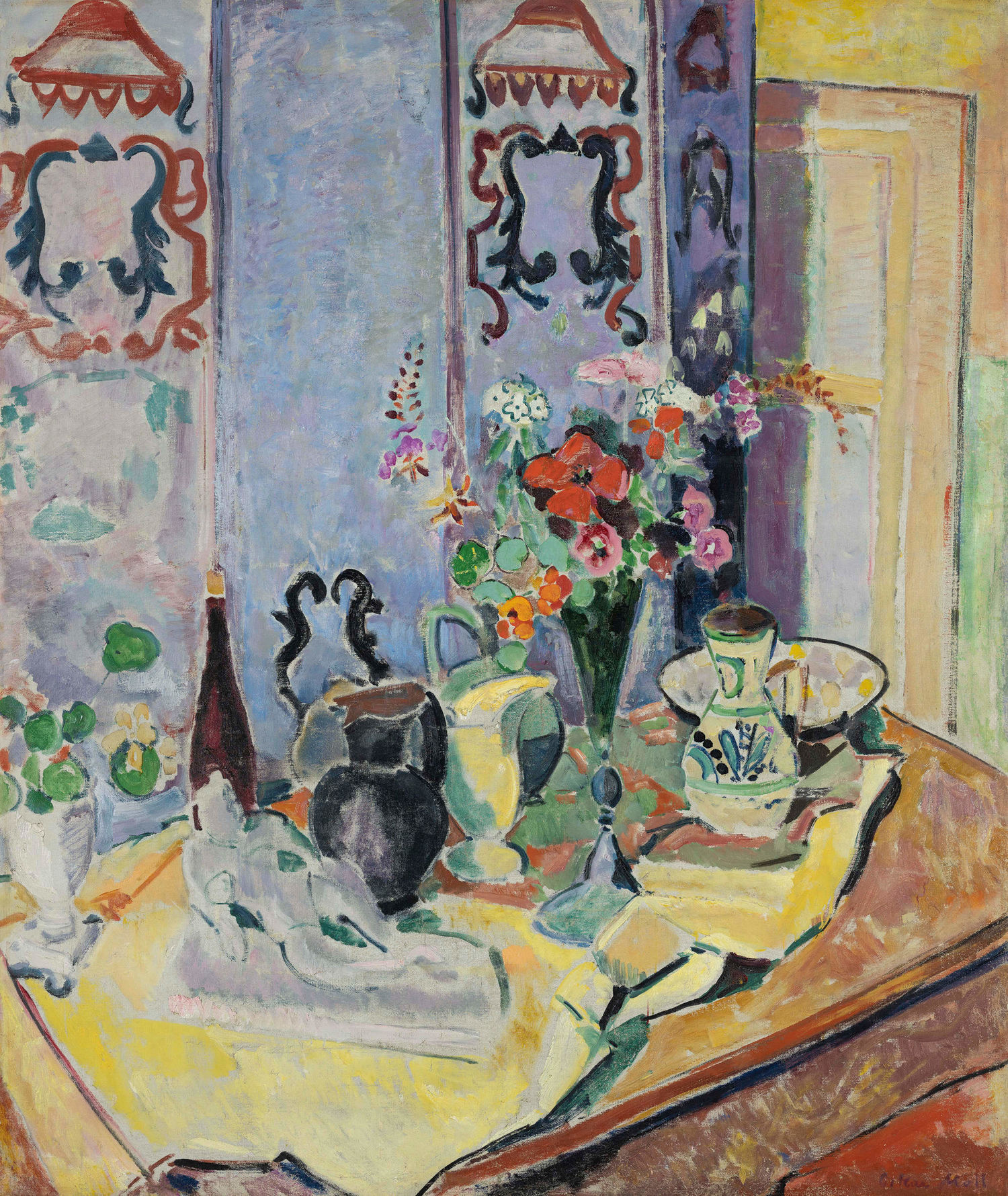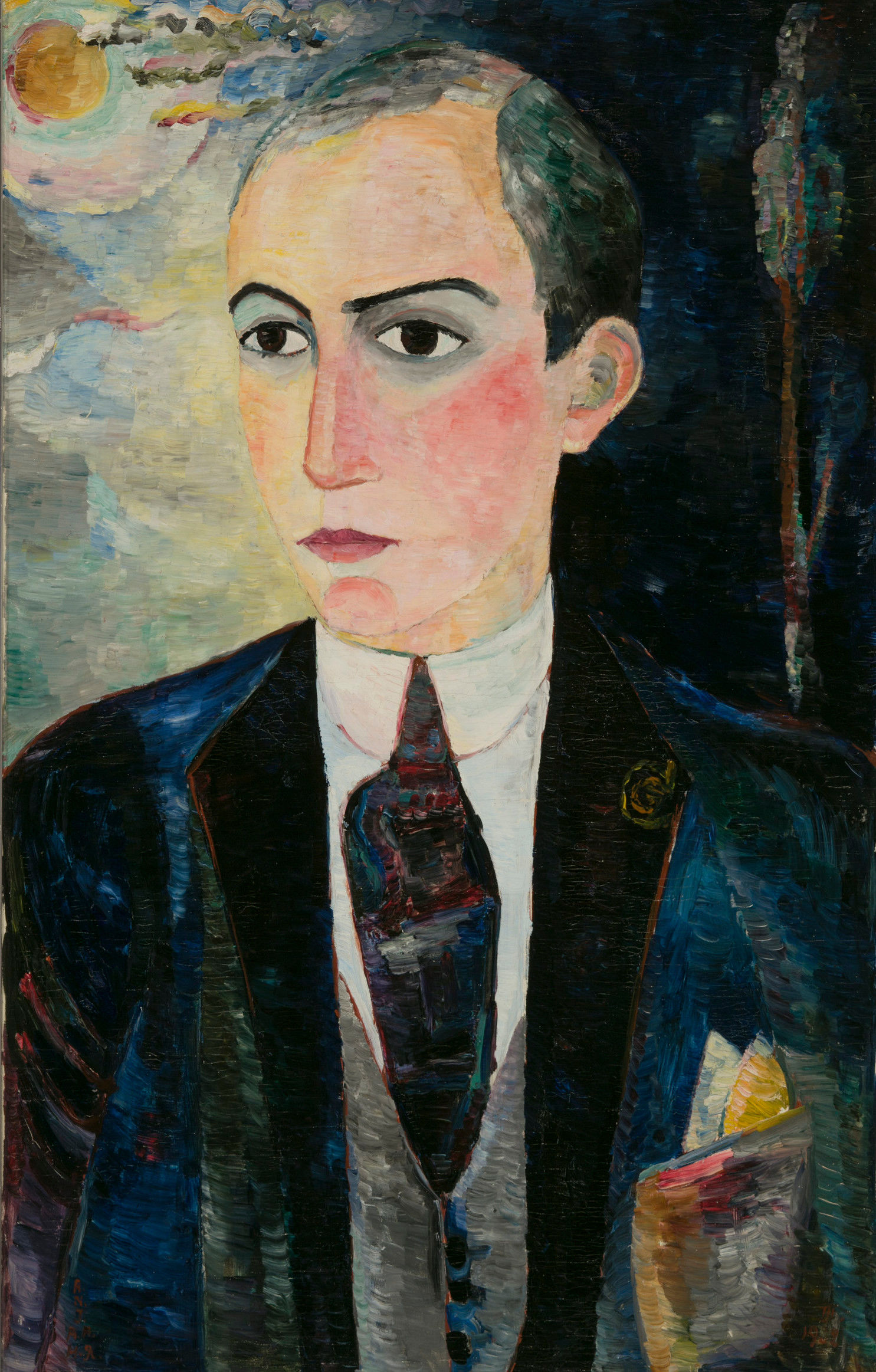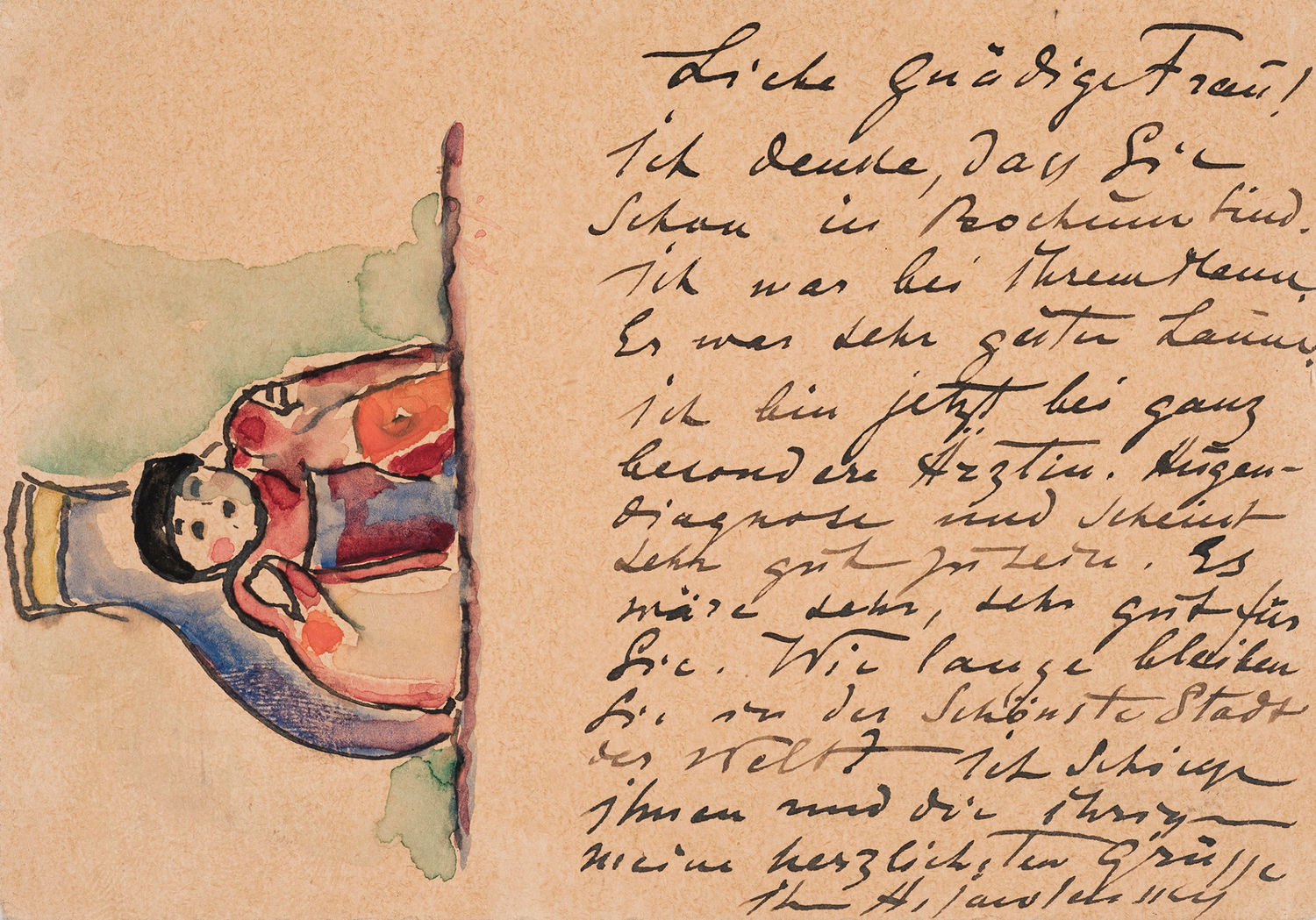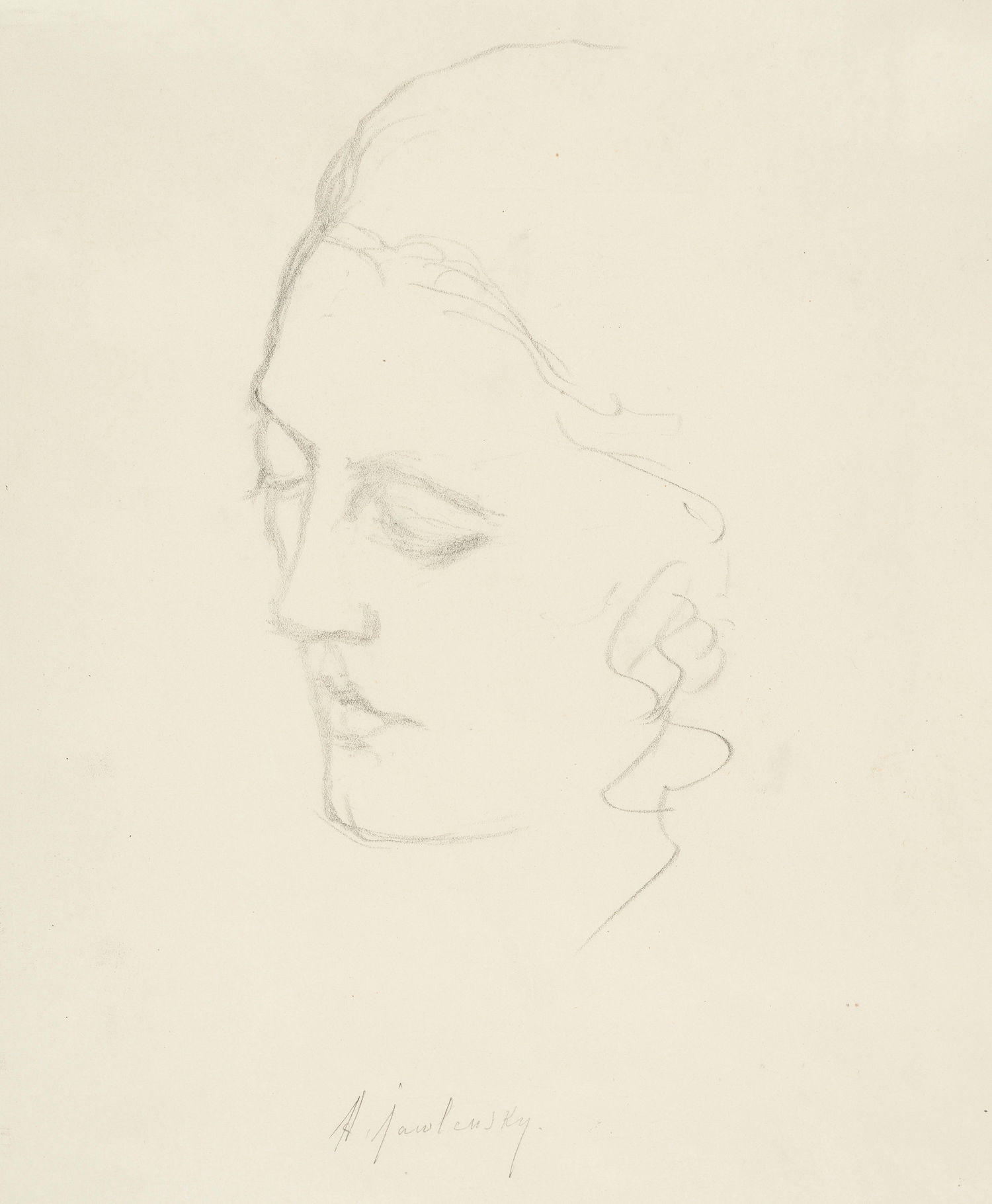View into the exhibition. Photo: Museum Wiesbaden / Bernd Fickert
A centennial exhibition such as The Lot! 100 Years of Jawlensky in
Wiesbaden, currently on view until 22 March, can have a wonderfully stirring effect in museum life. It opens valves, allowing the blood to flow through all areas vital in the running of a dynamic museum — enlivening scholarship, public engagement, and patronage. The centennial exhibition commemorates, in our present day, a long-past event: Jawlensky’s alighting at Wiesbaden Hauptbahnhof in June 1921, which turned out to be a fateful day for art in the city. This year saw the publication of a hefty collection catalogue, the mapping out of the Jawlensky Walk across the city, and the welcome surprise of a small showering of gifts. The most recent of which arrived just one week ago — but more on that later. Let’s not get ahead of ourselves in naming the works — chronologically – that have been so generously given to us this year.

...with a major work by Oskar Moll: his magnificent Still Life with Small Matisse Sculpture, which had once belonged to the Städel Museum until it was impounded by the Nazis in 1937 as part of their campaign against ‘degeneracy’ in modern art. Two years ago almost to the day, Dr. Roman Rubin, a local collector, announced his intention to donate the painting to our museum in 2021. It was agreed that the canvas would have its first showing as a museum piece in the framework of our Jawlensky anniversary. Why, one may ask, if it wasn’t by Jawlensky himself? Well, it made perfect sense insofar as it further underlines Matisse’s impact on art at the time. In fact, Oskar Moll had joined other émigré German artists in founding the Académie Matisse in Paris in 1908. And as his painting shows, Jawlensky, too, had many points of contact with the famous father of Fauvism. Scholars assume that Jawlensky’s first encounter with Matisse occurred very early on, in 1905 and 1906, when he featured at the Paris Autumn Salon at the Grand Palais two years in a row.


As many of you will have already heard, at the official exhibition opening, Angelica Jawlensky Bianconi, the artist’s granddaughter, announced that she intends to gradually relinquish control over the Jawlensky Archive, which she manages in Switzerland. She will hand it over to our museum incrementally over the next four years. The move will see the formation of a new scholarly resource at Museum Wiesbaden: the Alexej von Jawlensky Research Archive. But even before this year’s announcement, Angelica Jawlensky Bianconi also donated two artworks to our museum, one by her father and one by her grandfather.
The post-Expressionist Portrait of Hans Baur by Andreas Jawlensky from 1922 is one of the few surviving pre-war works by the German artist. Most of his early work was sadly lost in the bombing of Wiesbaden, when the house at Beethovenstraße 9 was destroyed on 2 February 1945. Meanwhile, the delightful small watercolor by Alexej von Jawlensky, painted on the back of a postcard in cheerful salutation to Tony Kirchhoff (wife of collector Heinrich Kirchhoff), makes a distinctly Russian impression, as it inevitably evokes matryoshka dolls.

Tony Kirchhoff, addressee of that postcard, displayed great curatorial courage by daring to exhibit Jawlensky’s art at the Märkisches Museum Witten in 1936, three years into the Nazi regime, by which time the artist’s work had officially been branded ‘degenerate’. There are only a few degrees of separation between Kirchhoff and Lisa Kümmel. A couple from the Taunus region, who prefer to remain unnamed and who have been closely following our museum work for many years, recently gave us a charming portrait drawing of Lisa Kümmel shortly before the new Jawlensky collection catalogue went to press. Jawlensky probably made the drawing shortly after he met Kümmel in 1927. Not only did Kümmel go on to oversee operations at his studio, but it was she to whom the artist dictated his oft-cited memoirs in 1936–1937.
The fact that an important research archive on Alexej von Jawlensky is being built in Wiesbaden is also a consequence of the significant donation of an extensive collection of Jawlensky’s correspondence. Marian Stein-Steinfeld, granddaughter of Hanna Bekker vom Rath and director of the Hanna Bekker Archivs in Frankfurt, presented Museum Wiesbaden with forty letters from Jawlensky’s correspondence with her grandmother, dating from the period 1926 to 1940. The correspondence is vivid testimony to a warm friendship, lasting many years, that existed between the artist and his patron. In our recently published catalogue, Stein-Steinfeld traced this relationship with great sensitivity by closely reviewing their correspondence. One of the most revealing passages is the brief mention of a studio visit by the Constructivist thinker Ernö Kállai: “Mr. Kallei paid me a visit,” Jawlensky wrote to Hanna Bekker on 15 November 1932. The artist then goes on to say: “A Hungarian, art writer, sensitive, knows a lot. Speaking about my heads, he said: Quite beautiful; you are a born colorist! No. That isn’t quite it. I am a religious person. My art is a prayer. Icons. I think I think about art.”
The last donation reached us just ten days ago. And it was ultimately this last small surprise from Angelica Jawlensky Bianconi that gave us the idea of writing this blog post. Not only do we wish to show how our collection continues to grow, but, most importantly, we also want to take this opportunity to say a big THANK-YOU to all the above-mentioned patrons of our museum. This latest addition – this latest gem – went on immediate display. After being on view in a cabinet in the first room of the exhibition for a week now, it appears to have at last found its proper place in our museum. But what is it and who is it by?

Oskar Schlemmer, who actually had little to do with Jawlensky, decided on the spur of the moment to paint this postcard In Memoriam Alexej v. Jawlensky, upon hearing of his fellow artist’s death in 1941. Tellingly, he posted the card to his friend Dieter Keller on the Eastern Front in Russia. Both the loose brushwork and intensity of the colors are deliberately evocative of the Russian artist’s work. The colors turn this sad piece of news into a homage of inspiring solace in the midst of war.
What happened in the years leading up to his death and how the collection of Jawlensky's works has grown to the present day is the subject of the major anniversary exhibition The Lot! 100 Years of Jawlensky in Wiesbaden. The 111 works in the museum's holdings, which outline Jawlensky's entire oeuvre from expressive heads to serial works, will be presented in their entirety for the first time in the museum's history.
Hier finden Sie das Begleitprogramm zur Ausstellung, sobald es im Veranstaltungskalender veröffentlich wurde.